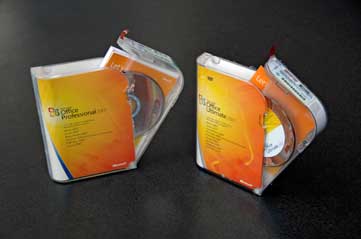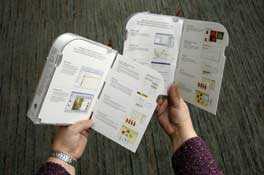REDMOND, Wash. – Aug 25, 2009 – The latest version of Microsoft Office can help update a resume, get a grip on a household budget or speed up work on a school paper. But times are tough. In search of a bargain, it’s tempting to run a quick search online and find a sealed copy of the standard Microsoft Office 2007 suite, which usually sells for $400 package, for $200. A couple more clicks and it’s in the mail.
Too good to be true? Most likely, yes. In fact, it’s so good, it’s probably either counterfeit or pirated.

Can you tell which version is counterfeit Microsoft Office? The genuine version is on the right.
When software comes with a price tag that is substantially lower than the manufacturer’s suggested retail price, it’s frequently non-genuine. Often, customers in search of bargain-basement prices — or even looking to shave just a few dollars off of the full retail price — unknowingly buy pirated software from vendors selling meticulously forged software packages.
According to a recent study conducted by the Business Software Alliance (BSA) and market research firm IDC, 41 percent of the software on PCs around the world in 2008 was either counterfeit or used without a license. While piracy remains a serious global problem, Microsoft has been continually working with governments, enforcement agencies and industry associations such as the BSA to protect customers from the risks of non-genuine software.
So starting today, in an effort to increase the reach of its anti-piracy initiatives, Microsoft has expanded its Office Genuine Advantage (OGA) notifications program into 13 additional countries and territories, taking the total to 41.
Says Debbie Walsh, director of emerging markets and license compliance in Microsoft’s Information Worker product group: “When customers are misled into buying non-genuine software, they forfeit access to technical support, upgrades, user manuals and bug fixes. Even worse, they are forced to deal with incomplete software code and increase the risk of exposing their PC to debilitating viruses that could destroy data and steal personal information. Through programs like Office Genuine Advantage, Microsoft is determined to protect customers from the pitfalls of non-genuine software.”
OGA Widens Its Reach
Microsoft’s Office Genuine Advantage program, a voluntary initiative that is part of the company’s Genuine Software Initiative (GSI), helps customers confirm that the copy of Microsoft Office installed on their computer is genuine. The newly served countries and territories that will benefit from the expansion of the program are Austria, Brazil, Finland, Greece, India, Ireland, Netherlands, Peru, Puerto Rico, Switzerland, Taiwan, United Kingdom and the United States.
Customers in 41 countries now have the option to install OGA notifications, available through Microsoft Update, and learn whether they are running genuine versions of Office. By validating their copies of Office, consumers can take advantage of all the accompanying capabilities, support and upgrades. If the copy is found to be non-genuine, users are directed to a customized Microsoft Web page to view validation results and learn about easy steps to secure their PC.

It is no longer possible to identify non-genuine software by the packaging alone. Engineering advances such as OGA notifications will help protect customers from becoming unwitting victims. The genuine version of Microsoft Office is on the right.
“The only way to protect consumers is by educating them about software piracy, enabling them to make discerning purchasing decisions, and then providing solutions when they are unwittingly defrauded,” says Walsh. “The OGA program not only helps customers to differentiate the value of genuine Office products, but more importantly, it bolsters their confidence while shopping for software. Only then can they can enjoy the full range of Office capabilities and anticipate continuous system improvements.”
To be sure, counterfeiting and piracy exact a huge cost on software makers such as Microsoft as well as other vendors of intellectual property. Earlier this year, a joint report by the BSA and IDC noted that the cash value of unlicensed software now has broken the $50 billion level — up from estimates of $34 billion in losses in 2006. The report noted that lowering global piracy by just one point a year would add $20 billion in revenues to the IT industry.
But non-genuine software also costs consumers in ways they may not understand. Microsoft’s GSI educates customers on the value of genuine products, engineers creative anti-counterfeiting technologies, and works with governments and law enforcement agencies to promote the benefits of supporting legitimate software economies within their country.
As software pirates become more sophisticated, customers can no longer rely on being able to visually identify counterfeit software through the packaging alone. It has become critical for software manufacturers to tighten the anti-piracy features in their products and integrate piracy detection capabilities into the customer’s experience of product activation and validation. Microsoft is making advances through its Office Genuine Advantage program to do just that.
“Piracy is an industry-wide problem and it’s certainly not a victimless crime,” says Cori Hartje, senior director of Microsoft’s Genuine Software Initiative. “When non-genuine software comes bundled with hardware or when it is painstakingly packaged to look like the real deal, customers become unsuspecting victims. There are many methods that can be used to defraud consumers, and as an industry leader, Microsoft is constantly engaging in cross-company efforts through programs like Office Genuine Advantage to protect our partners and customers.”
As part of the Genuine Software Initiative, Microsoft encourages customers to use validation tools such as OGA and visit resource sites such as http://www.microsoft.com/genuine to check if the software they are running is genuine.
Preventing Risky Business
Software piracy doesn’t solely put individual consumers at risk. In business environments, IDC research indicates that the cost for an organization to recover from a solitary incident of malicious software on a single workstation can surpass $1,000. According to IDC-BSA forecasts, decreasing the piracy rate by 10 percentage points over the next four years could add more than 2.4 million new jobs and contribute almost $70 billion in tax revenues to local economies.
One of the most rampant forms of software piracy involves the misuse of volume license keys. Counterfeiters use these stolen keys to create installable software that may be incomplete and could potentially contain spyware and malware. Responding to the escalating piracy of volume license keys, Microsoft is adding volume licensing activation features to Office 2010. This upcoming version of Microsoft Office will offer technology managers new tools built on the existing Software Protection Platform that not only will make software piracy harder, but also will better enable businesses to manage their IT assets.
The forthcoming version of Office will bring together new anti-piracy innovations, counterfeit detection and tamper-resistant features into a complete platform that provides better software protection to programs that leverage it. Microsoft already has a track record of incorporating the Software Protection Platform into earlier products such as Windows 7 and Windows Server 2008, and Hartje adds that they are looking to replicate the same success with Office 2010.
“While future consumer installations will closely resemble what we have today, additional advantages that customers can expect include the ability to issue product keys that upgrade the installed version to one that is incrementally feature-rich,” says Hartje. “The ultimate goal of our programs that stem the flood of piracy is not only to lessen the impact of these illegal activities, but also to ensure that our customers enjoy all the capabilities — as well as the peace of mind — that come with using genuine software.”




